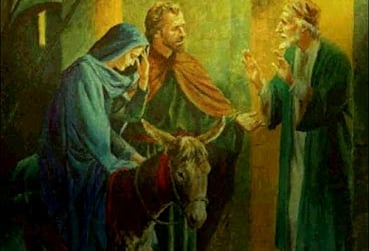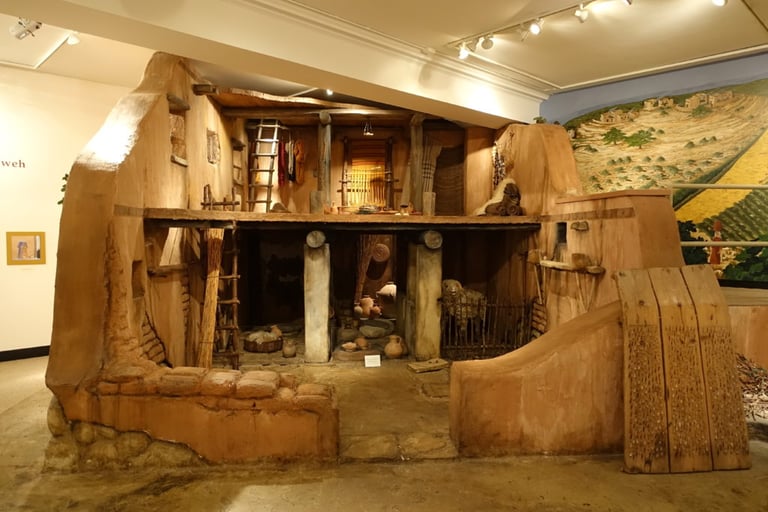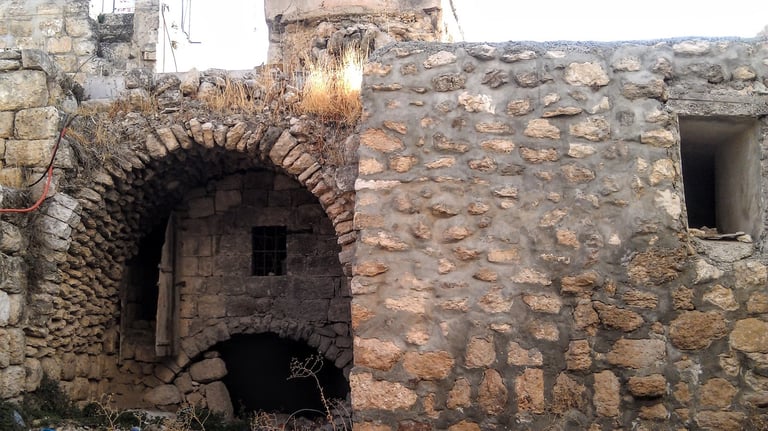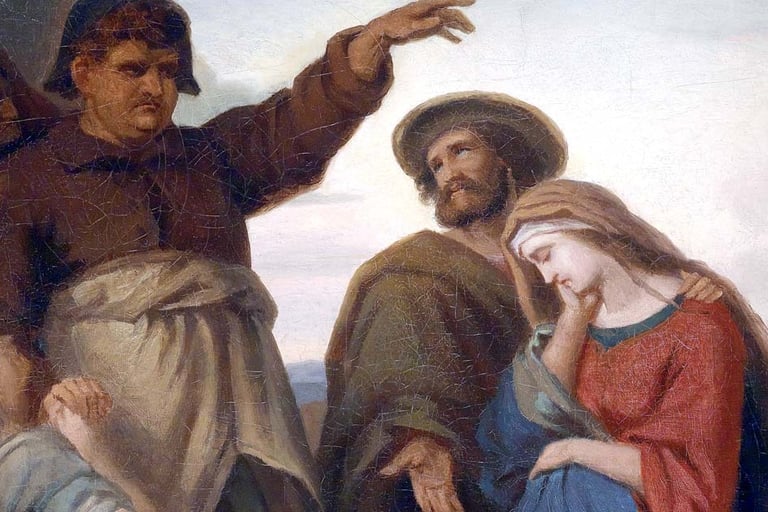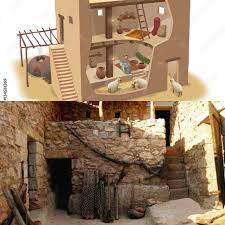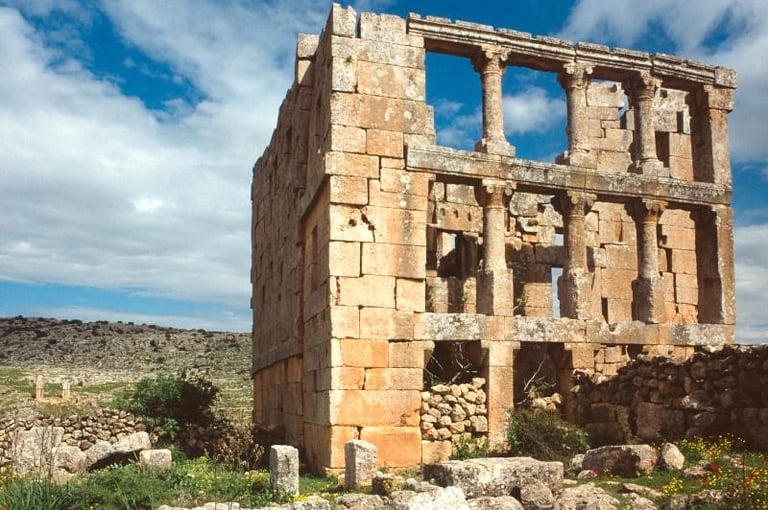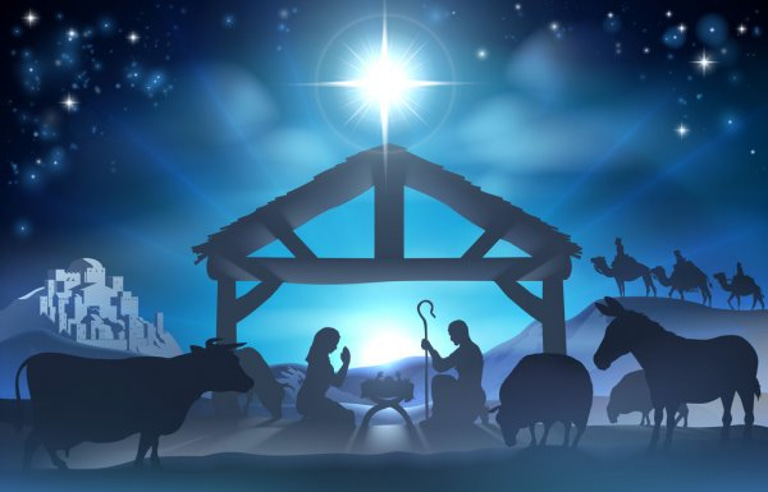Unveiling the Truth: Was There Really an Inn in Bethlehem?
Curious if an inn existed in Bethlehem during the Nativity? Explore historical and biblical views today for fresh insights and interpretations.
Grace Callahan
2/14/202511 min read
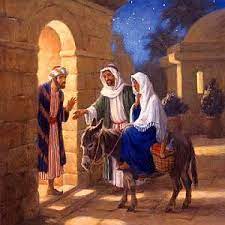

Introduction
Did you know that one of the most debated aspects of the Nativity story is whether an inn actually existed in Bethlehem? This question sparks curiosity and leads to deeper exploration of historical records, biblical texts, and archaeological findings. In this article, we will investigate the facts surrounding the Nativity, uncovering cultural contexts and common misconceptions. By examining how the story has changed over time, you will gain valuable insights into one of history's most beloved events. Get ready to discover the truth behind the Nativity narrative.
Bethlehem in the 1st Century: What Was It Really Like?
When we picture Bethlehem at the time of Jesus’ birth, what comes to mind? A quaint little village? A bustling trade hub? A quiet, overlooked town? The reality is far more complex, shaped by political tensions, economic struggles, and deeply ingrained cultural customs.
Bethlehem’s Role in the Roman World
Bethlehem wasn’t a major city like Jerusalem, but it wasn’t insignificant either. It held deep historical and religious meaning as the City of David (1 Samuel 16), a fact not lost on Jewish inhabitants under Roman rule. But politically? It was just another small Judean town caught in the empire’s vast network of taxation and control.
Roman Occupation & Local Struggles – Bethlehem’s residents were subject to heavy taxation, a reminder that they were under the thumb of a foreign power. The Herodian dynasty ruled as Rome’s puppet, and unrest simmered beneath the surface.
Economic Reality – Most people were farmers, shepherds, or tradesmen, eking out a living under a system designed to benefit the elite. While Jerusalem flourished, smaller towns like Bethlehem had limited economic opportunities.
How Did People Live? Lodging, Travel, and Hospitality
Forget modern hotels or cozy inns—lodging in ancient Judea was an entirely different experience. Travelers often relied on hospitality from locals, as Middle Eastern culture placed heavy emphasis on welcoming guests. But Bethlehem, swelling with people due to the Roman census, would have been chaotic.
Private Homes & Guest Rooms – Many houses had upper rooms for guests rather than separate inns (the Greek word often translated as "inn" in Luke 2:7 is kataluma, which more accurately means “guest space”).
Communal Living – Extended families lived together, often in multi-generational homes. Privacy? A luxury few enjoyed.
Public Shelter? Limited. – Public accommodations were rare, and those available were basic at best. Think shared sleeping areas, rough conditions, and little in the way of comfort.
What Does Archaeology Tell Us?
Modern excavations give us glimpses into daily life. Remnants of homes, storage facilities, and water systems suggest Bethlehem was a modest but functioning settlement.
Ancient House Structures – Most were built with limestone, featuring courtyards and shared spaces rather than individual rooms.
Cave Dwellings & Mangers – Some families used caves as homes or stables. This aligns with the theory that Jesus was born in a house where the lower level (often used for animals) contained a feeding trough—a manger.
A Town Steeped in History, Yet Unremarkable?
Bethlehem in the 1st century wasn’t glamorous, but it was real—gritty, ordinary, and deeply connected to its Jewish roots. It was a place of political tension, economic struggle, and humble existence. And yet, from this unassuming village came a story that changed history.
The Nativity: What the Bible Actually Says (and What We Get Wrong)
The Nativity story is one of the most famous in human history, but if we take a closer look, we realize how much tradition has shaped our understanding—sometimes more than Scripture itself. The biblical accounts in Luke and Matthew give us different angles on the same event, and when we dig into historical context, certain long-held assumptions start to unravel.
What the Gospels Actually Say
Unlike the polished Christmas pageants we’re used to, the biblical accounts are surprisingly sparse on details.
Luke’s Gospel (Luke 2:1-20): This is where we get the journey to Bethlehem, the manger, and the angelic announcement to the shepherds. But no mention of an innkeeper, a stable, or even animals.
Matthew’s Gospel (Matthew 2:1-12): No journey to Bethlehem here! Instead, Matthew focuses on the Magi, Herod’s paranoia, and the family’s escape to Egypt. No manger scene at all.
And what about that infamous “no room at the inn”? That might not mean what we think.
Manger vs. Inn: Have We Been Reading It Wrong?
The Greek word often translated as "inn" in Luke 2:7 is kataluma, which more accurately means "guest space"—the same word used for the Upper Room where Jesus had His Last Supper (Luke 22:11). If Luke had meant a commercial inn, he would have used pandocheion, like in the Good Samaritan story (Luke 10:34).
So, what does this mean?
Mary and Joseph likely stayed in a family home, not a public inn. But the guest room was already occupied, so they had to settle in the main living space—where animals were sometimes kept at night.
The manger wasn’t a standalone stable. Many homes had a feeding trough built into the ground level, meaning Jesus was born in a household setting, not a barn.
This small translation difference completely reshapes how we picture the birth of Jesus. Instead of a desperate couple turned away by a heartless innkeeper, we see a family making do in a crowded home—surrounded by relatives, not strangers.
Did Prophecy Shape the Story?
The Nativity isn’t just about what happened; it’s also about what was expected to happen. The Gospel writers—especially Matthew—draw heavily from the Old Testament to show how Jesus fulfilled messianic prophecies.
Micah 5:2 – Bethlehem’s Role
“But you, Bethlehem... out of you will come for me one who will be ruler over Israel.” Matthew explicitly connects this to Jesus, reinforcing that His birth wasn’t random—it was foretold.Isaiah 7:14 – The Virgin Birth
“The virgin will conceive and give birth to a son...” While debated, Matthew cites this as a direct prophecy fulfilled in Jesus’ birth.Hosea 11:1 – The Flight to Egypt
“Out of Egypt I called my son.” Originally about Israel’s exodus, Matthew reinterprets it to fit Jesus’ early life.
But here’s the big question: Did the prophecy shape the narrative, or did the narrative shape how the prophecy was understood? This is where history, theology, and interpretation collide.
The Nativity: More Real, Less Romanticized
Stripping away centuries of tradition, the birth of Jesus looks less like a Hallmark scene and more like a raw, real-world event—a young mother giving birth under crowded, less-than-ideal conditions in an occupied land. And that makes it all the more powerful.
The Inn Theory: A Misreading of the Nativity?
For centuries, we’ve pictured a desperate Mary and Joseph being turned away by a grumpy innkeeper, forced to take shelter in a lonely stable. But was there ever an inn at all? Or is this a case of historical mistranslation and evolving tradition? Let’s break it down.
Where Did the “Inn” Idea Come From?
The concept of an overcrowded inn isn’t in the Bible—it developed over time through tradition, storytelling, and mistranslation.
Early Christian Writings: The first few centuries of Christian thought didn’t emphasize an inn. The focus was more on the theological meaning of Jesus’ humble birth rather than the logistics.
Medieval Dramatizations: By the Middle Ages, Nativity plays and paintings had cemented the stable-and-innkeeper narrative in Christian imagination. This made for a more dramatic, relatable story: the rejected Holy Family, the humble Savior born among animals.
English Bible Translations: Many English versions of the Bible translated kataluma (Luke 2:7) as "inn," reinforcing the idea in Western Christianity. The King James Version (1611) played a significant role in this.
But none of this proves there was an actual inn in Bethlehem at the time.
The Scholarly Debate: Was There Ever an Inn?
Historians and biblical scholars are almost unanimous in arguing that the traditional "inn" is a misinterpretation. Here’s why:
The Greek Word Kataluma
Used in Luke 22:11 to describe the Upper Room, not an inn.
If Luke had meant a commercial inn, he would have used pandocheion (like in the Good Samaritan parable, Luke 10:34).
How Ancient Judeans Housed Travelers
Hospitality was a sacred duty in Jewish culture. Travelers stayed in family homes, not public inns, unless absolutely necessary.
Most homes had a main living area where animals were kept at night, making a manger an expected feature—not something separate in a barn.
What Archaeology Tells Us
Excavations in 1st-century Judean towns show no evidence of formal inns, but rather domestic homes with guest areas.
Bethlehem was a small town, unlikely to have had a dedicated travelers' inn at all.
So, where does that leave the traditional inn-and-stable story? More fiction than fact.
How Modern Scholars and Culture Interpret It
Today, most biblical scholars argue that Mary and Joseph likely stayed with extended family, not at an inn. The lack of space in the kataluma (guest room) forced them into the main living area, where a manger was present.
But despite strong academic arguments, popular culture still clings to the inn narrative:
Nativity Scenes & Christmas Pageants – The stable setting remains central, even though the Bible never mentions one.
Movies & Art – From Renaissance paintings to modern films, the lonely stable continues to dominate.
Preaching & Tradition – Many sermons still emphasize “no room at the inn” as a metaphor for spiritual rejection.
So, Was There an Inn in Bethlehem?
Almost certainly not. The innkeeper, the crowded lodging, the detached stable—these are later embellishments that shaped the Christmas story but aren’t backed by history or Scripture.
Does that mean the Nativity is less meaningful? Hardly. If anything, realizing Jesus was born among family, in a humble home, makes the story even more authentic and culturally grounded.
The Inn That Wasn’t: How a Mistranslation Shaped Christmas Tradition
For centuries, the image of a weary Mary and Joseph being turned away from an inn has been ingrained in Christmas culture. We see it in art, music, literature, and film, reinforcing a version of the Nativity story that isn’t actually biblical. But how did this narrative take on such symbolic weight, and what can it teach us about faith, tradition, and the power of storytelling?
The Nativity in Art, Film, and Literature
From medieval paintings to blockbuster films, the Nativity scene has been a central theme in Western artistic tradition. But interestingly, the portrayal of the inn has evolved with culture:
Early Christian Art (2nd–6th century): The focus was on the manger, not an inn. Catacomb frescoes in Rome depict a domestic setting, not a stable.
Medieval & Renaissance Art: By this time, the stable scene was fully formed. Painters like Giotto and Caravaggio romanticized the isolation of the Holy Family, reinforcing the idea of rejection.
Literature & Theater: Medieval Nativity plays introduced the innkeeper as a character, adding drama to the story. Later, authors like Charles Dickens and C.S. Lewis referenced the imagery of the inn as a symbol of human indifference.
Hollywood & Pop Culture: From The Nativity Story (2006) to countless animated specials, the “no room at the inn” trope remains a dramatic focal point.
It’s fascinating to see how a single mistranslation (kataluma as "inn") shaped centuries of art and storytelling.
How Christmas Traditions Reinforced the Inn Narrative
Different cultures have adopted and reimagined the Nativity scene, often emphasizing the idea of rejection and divine humility.
Las Posadas (Mexico & Latin America): A reenactment of Mary and Joseph seeking shelter, knocking on doors and being turned away—directly influenced by the “inn” tradition.
European & American Nativity Scenes: Stables, wooden mangers, and a distant innkeeper remain central, even though they’re historically inaccurate.
Filipino Simbang Gabi: Early morning Christmas masses include reflections on the journey to Bethlehem, often framed around the “no room” theme.
Personal stories vary, but many people recall childhood Christmas pageants where someone had to play the poor, unsympathetic innkeeper—a character who never even appears in Scripture!
What This Debate Teaches Us About History and Faith
So, if the inn wasn’t real, does it matter? Absolutely. The evolution of this story gives us important insights into how traditions develop and what they reveal about human nature.
The Power of Storytelling: The emotional pull of rejection and humility made the “inn” a compelling addition to the Nativity. Even historical inaccuracies can carry symbolic truth.
Faith and Interpretation: Understanding the cultural and linguistic context of biblical texts helps us separate literal history from theological meaning.
How Legends Evolve: Just like other religious and historical stories, the Nativity has been shaped by art, translation, and cultural imagination.
Ultimately, the real Nativity story—Jesus born into a humble home, welcomed into a crowded family setting—carries just as much, if not more, theological significance than the traditional stable-and-innkeeper narrative.
Reconciling History and Faith: Why the Nativity Debate Matters
Does it really matter whether Jesus was born in a stable or a crowded family home? For some, the details of the Nativity are secondary to its theological meaning. For others, historical accuracy strengthens their understanding of faith. So how do we navigate the balance between evidence and belief?
The debate over the “inn” in Bethlehem isn’t just about linguistics or archaeology—it’s about how we interpret sacred narratives in a world that values both faith and historical inquiry.
Balancing Evidence and Belief
It’s natural to wonder: If we’ve been getting this detail wrong for centuries, what else might we have misunderstood? But this question shouldn’t lead to skepticism or doubt—rather, it should encourage a more informed and mature faith.
Faith and History Can Coexist. Many theologians argue that historical accuracy enhances, rather than threatens, religious belief. Understanding 1st-century Judean culture adds richness to the Christmas story rather than taking anything away.
The Bible’s Message Remains the Same. Whether Jesus was born in a stable or a home, the core truth remains: God entered the world in humility, not grandeur.
The Importance of Context. Scholars like N.T. Wright and Craig Keener emphasize the need to read Scripture in its original cultural and historical context, rather than through modern Western assumptions.
History provides context. Faith provides meaning. The two should work together, not against each other.
What This Means for Modern Believers
For many Christians, the traditional Nativity scene carries deep emotional and spiritual significance. Does learning that Jesus was likely born in a home change that? Not necessarily. Instead, it opens up new ways to appreciate the story:
A More Relatable Nativity: Instead of rejection by strangers, imagine Jesus being born in a crowded, bustling home, surrounded by extended family. This emphasizes God’s presence in everyday life rather than isolation.
A Deeper Theology of Hospitality: If Jesus was born in a home, it highlights the importance of welcoming others—a powerful theme in Scripture.
Faith Over Romanticized Tradition: Traditions are beautiful, but they shouldn’t replace biblical truth. Learning to separate cultural additions from Scripture can deepen one’s faith rather than diminish it.
It’s not about dismantling Christmas traditions; it’s about seeing them with fresh eyes.
Encouraging Further Research
For those who want to explore this topic beyond surface-level discussions, here are some great resources:
Books:
Jesus Through Middle Eastern Eyes – Kenneth Bailey (explores cultural context of the Nativity)
The New Testament in Its World – N.T. Wright & Michael F. Bird (historical context of early Christianity)
Misreading Scripture with Western Eyes – E. Randolph Richards & Brandon J. O’Brien (how cultural assumptions affect Bible interpretation)
Online Resources:
Biblical Archaeology Society – Articles on historical and archaeological insights into the Bible
The Center for the Study of New Testament Manuscripts – Research on biblical texts and manuscript history
N.T. Wright Online – Courses and lectures on historical Jesus studies
Engaging in Discussions:
Approach conversations with curiosity, not defensiveness—ask why certain traditions developed rather than just dismissing them.
Use historical insights to build bridges, not debates—many believers find deeper meaning in the real-world setting of the Bible.
Final Thought: Why It All Matters
The Nativity story is not weakened by historical study—if anything, it becomes richer and more tangible when we place it in its real-world setting. A historically accurate Jesus is a more human, relatable Jesus—and that only makes His story more profound.
History and faith aren’t enemies. When we embrace both, we move beyond shallow tradition and into a deeper, more authentic understanding of the life and message of Jesus.
Conclusion
The question of whether there was an inn in Bethlehem adds depth to our understanding of the Nativity story. By exploring the historical and biblical details, we've highlighted the complexities of this narrative. Regardless of your view, this discussion invites us to appreciate the rich layers of history and faith intertwined in this significant event. Think about the different perspectives shared here and consider how they shape your own beliefs. Continue your exploration of history and its impact on culture and faith.
